headlights TOYOTA FR-S 2015 Owners Manual (in English)
[x] Cancel search | Manufacturer: TOYOTA, Model Year: 2015, Model line: FR-S, Model: TOYOTA FR-S 2015Pages: 416, PDF Size: 5.25 MB
Page 6 of 416
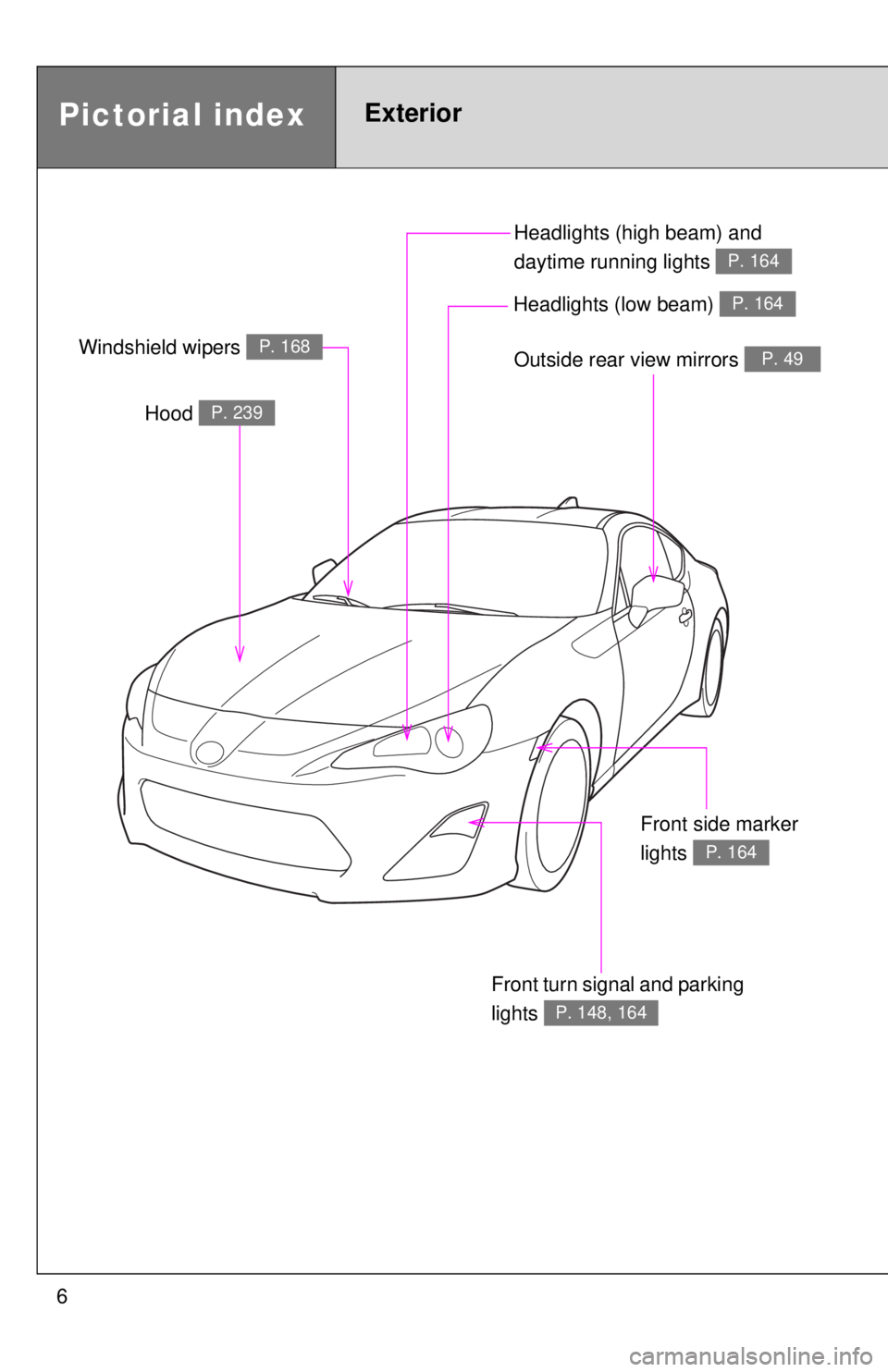
6Headlights (high beam) and
daytime running lights
P. 164
Pictorial indexExterior
Outside rear view mirrors P. 49
Front turn signal and parking
lights
P. 148, 164
Hood P. 239
Windshield wipers P. 168
Headlights (low beam) P. 164
Front side marker
lights
P. 164
Page 153 of 416
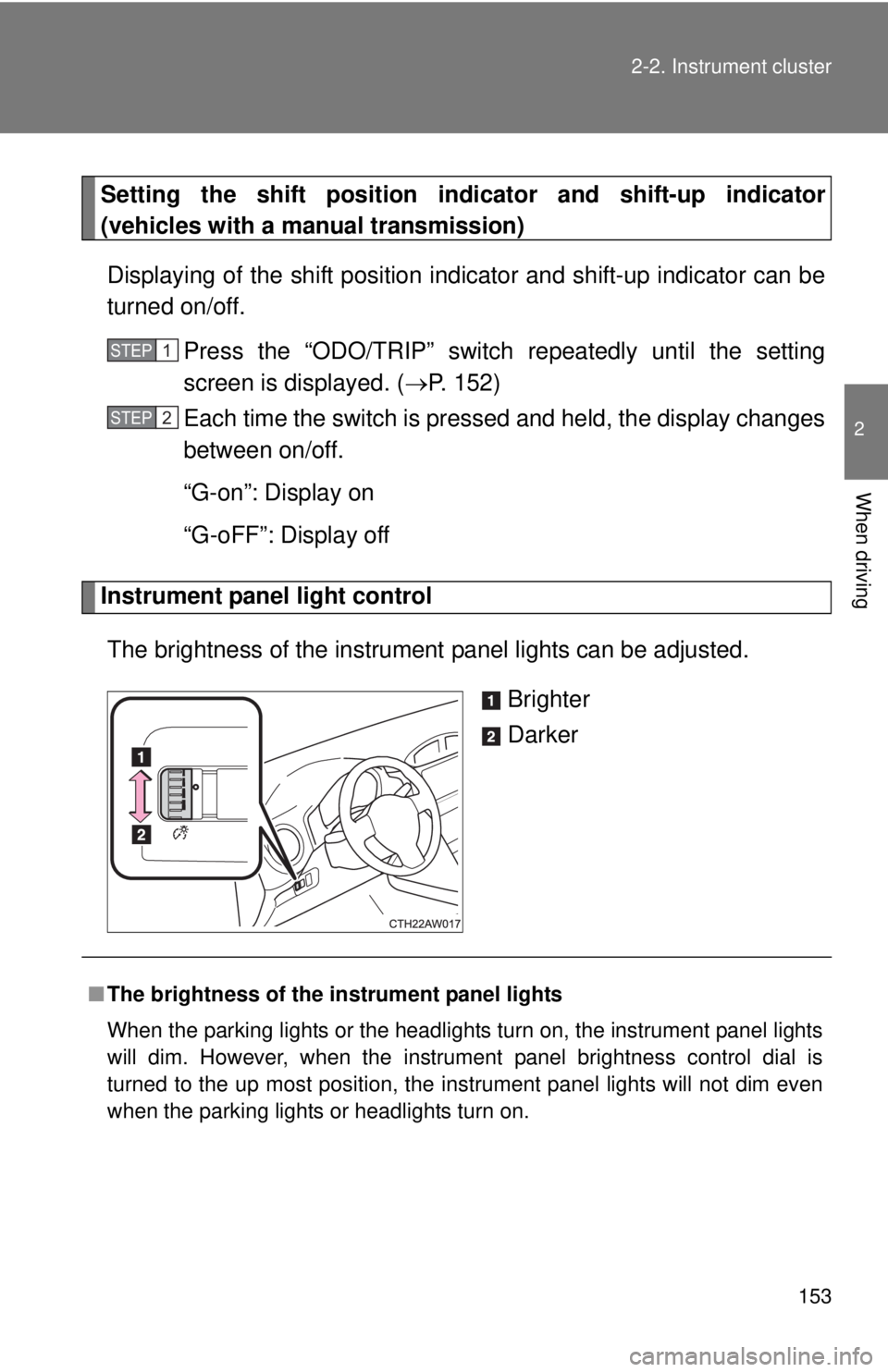
153
2-2. Instrument cluster
2
When driving
Setting the shift position indicator and shift-up indicator
(vehicles with a manual transmission)
Displaying of the shift position i ndicator and shift-up indicator can be
turned on/off.
Press the “ODO/TRIP” switch repeatedly until the setting
screen is displayed. ( P. 152)
Each time the switch is pressed and held, the display changes
between on/off.
“G-on”: Display on
“G-oFF”: Display off
Instrument panel light control
The brightness of the instrument panel lights can be adjusted.
Brighter
Darker
STEP 1
STEP 2
■The brightness of the instrument panel lights
When the parking lights or the headlights turn on, the instrument panel lights
will dim. However, when the instrument panel brightness control dial is
turned to the up most position, the instrument panel lights will not dim even
when the parking lights or headlights turn on.
Page 164 of 416
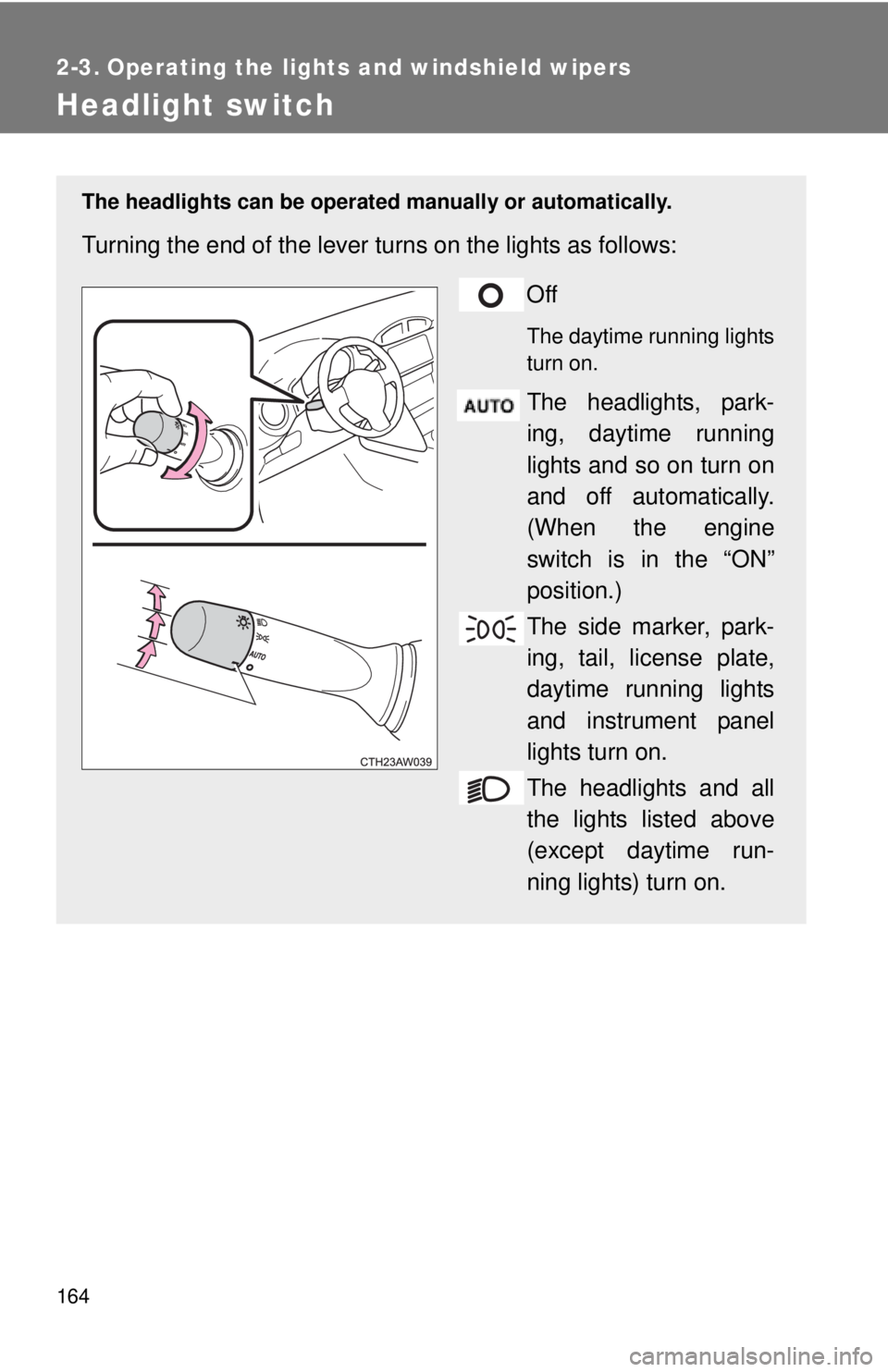
164
2-3. Operating the lights and windshield wipers
Headlight switch
The headlights can be operated manually or automatically.
Turning the end of the lever turns on the lights as follows:
Off
The daytime running lights
turn on.
The headlights, park-
ing, daytime running
lights and so on turn on
and off automatically.
(When the engine
switch is in the “ON”
position.)
The side marker, park-
ing, tail, license plate,
daytime running lights
and instrument panel
lights turn on.
The headlights and all
the lights listed above
(except daytime run-
ning lights) turn on.
Page 165 of 416
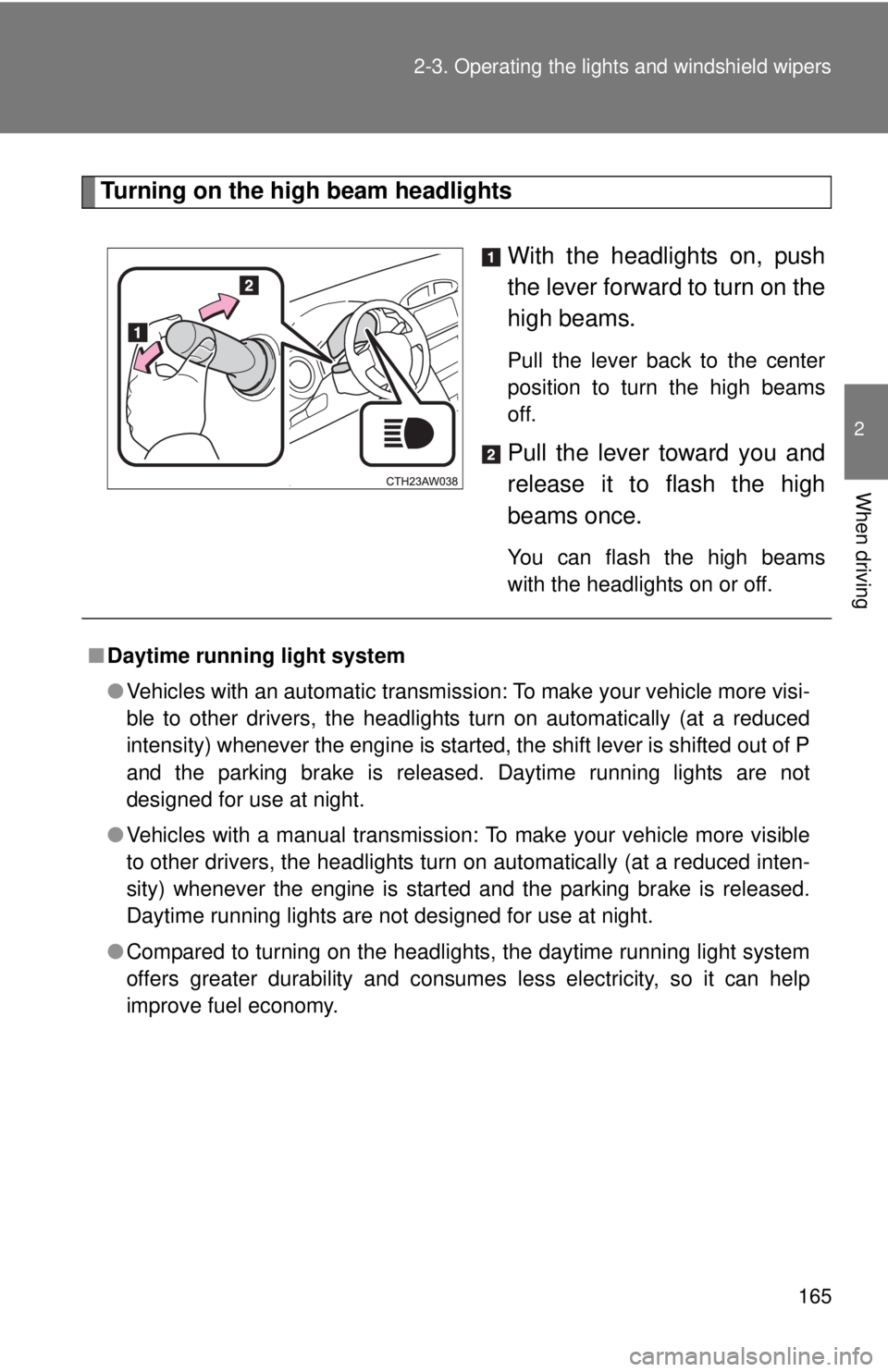
165
2-3. Operating the lights and windshield wipers
2
When driving
Turning on the high beam headlights
With the headlights on, push
the lever forward to turn on the
high beams.
Pull the lever back to the center
position to turn the high beams
off.
Pull the lever toward you and
release it to flash the high
beams once.
You can flash the high beams
with the headlights on or off.
■Daytime running light system
●Vehicles with an automatic transmission: To make your vehicle more visi-
ble to other drivers, the headlights turn on automatically (at a reduced
intensity) whenever the engine is started, the shift lever is shifted out of P
and the parking brake is released. Daytime running lights are not
designed for use at night.
● Vehicles with a manual transmission: To make your vehicle more visible
to other drivers, the headlights turn on automatically (at a reduced inten-
sity) whenever the engine is started and the parking brake is released.
Daytime running lights are not designed for use at night.
● Compared to turning on the headlights, the daytime running light system
offers greater durability and consumes less electricity, so it can help
improve fuel economy.
Page 166 of 416
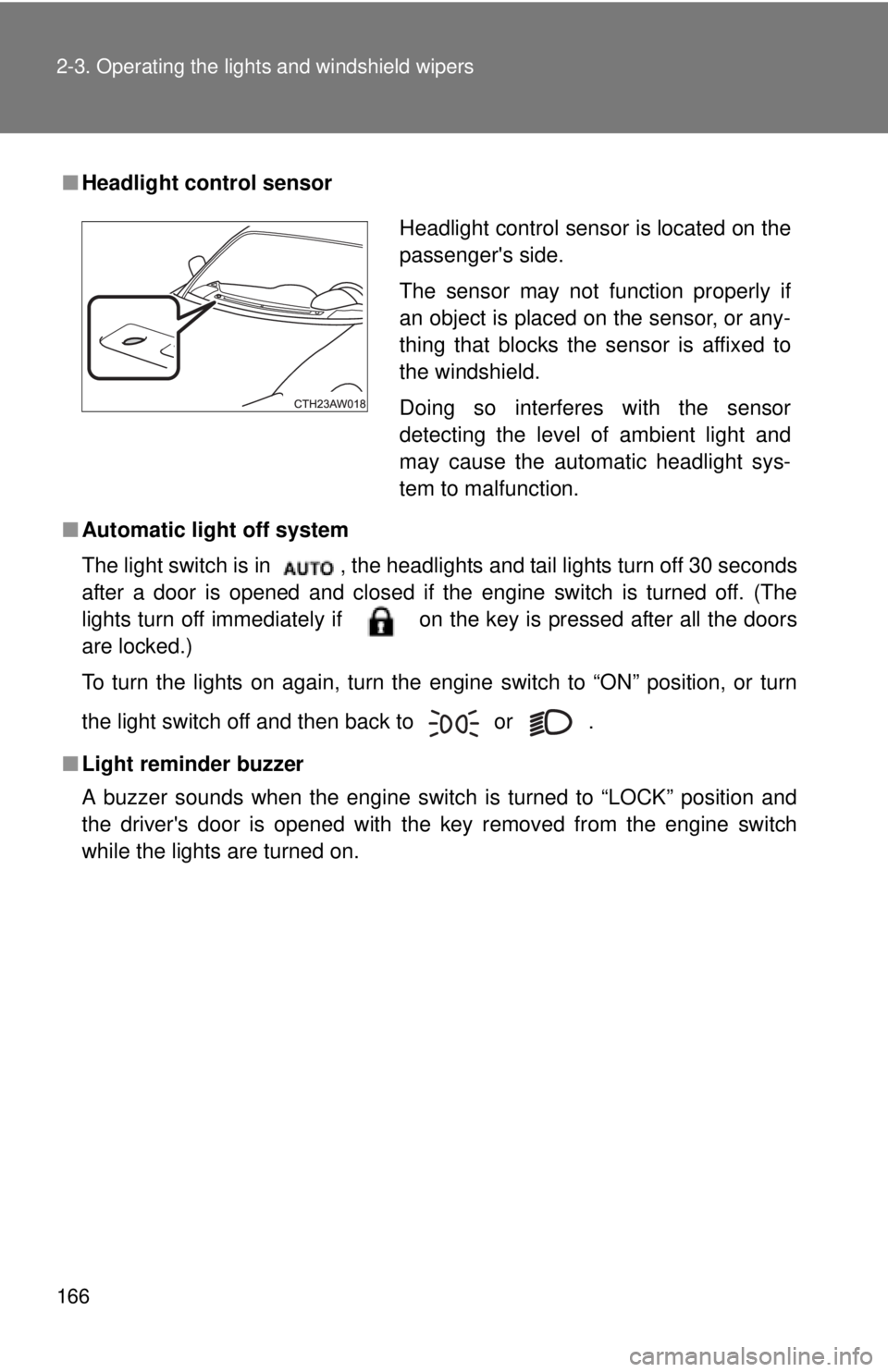
166 2-3. Operating the lights and windshield wipers
■Headlight control sensor
■ Automatic light off system
The light switch is in , the headlights and tail lights turn off 30 seconds
after a door is opened and closed if the engine switch is turned off. (The
lights turn off immediately if on the key is pressed after all the doors
are locked.)
To turn the lights on again, turn the engine switch to “ON” position, or turn
the light switch off and then back to
or .
■ Light reminder buzzer
A buzzer sounds when the engine switch is turned to “LOCK” position and
the driver's door is opened with the key removed from the engine switch
while the lights are turned on.
Headlight control sensor is located on the
passenger's side.
The sensor may not function properly if
an object is placed on the sensor, or any-
thing that blocks the sensor is affixed to
the windshield.
Doing so interferes with the sensor
detecting the level of ambient light and
may cause the automatic headlight sys-
tem to malfunction.
Page 167 of 416
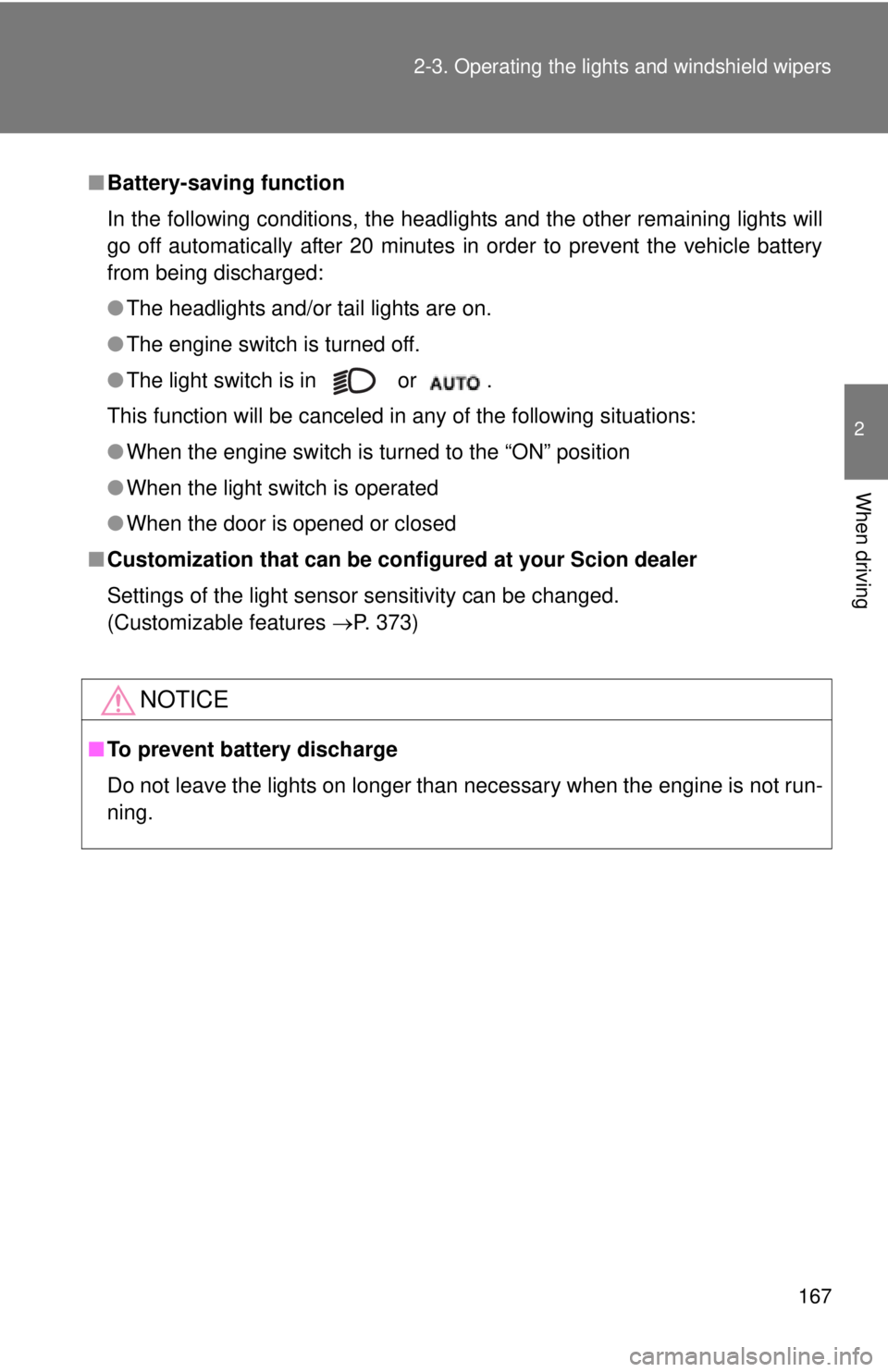
167
2-3. Operating the lights and windshield wipers
2
When driving
■
Battery-saving function
In the following conditions, the headlights and the other remaining lights will
go off automatically after 20 minutes in order to prevent the vehicle battery
from being discharged:
●The headlights and/or tail lights are on.
● The engine switch is turned off.
● The light switch is in or .
This function will be canceled in any of the following situations:
● When the engine switch is turned to the “ON” position
● When the light switch is operated
● When the door is opened or closed
■ Customization that can be conf igured at your Scion dealer
Settings of the light sensor sensitivity can be changed.
(Customizable features P. 373)
NOTICE
■To prevent battery discharge
Do not leave the lights on longer than necessary when the engine is not run-
ning.
Page 284 of 416
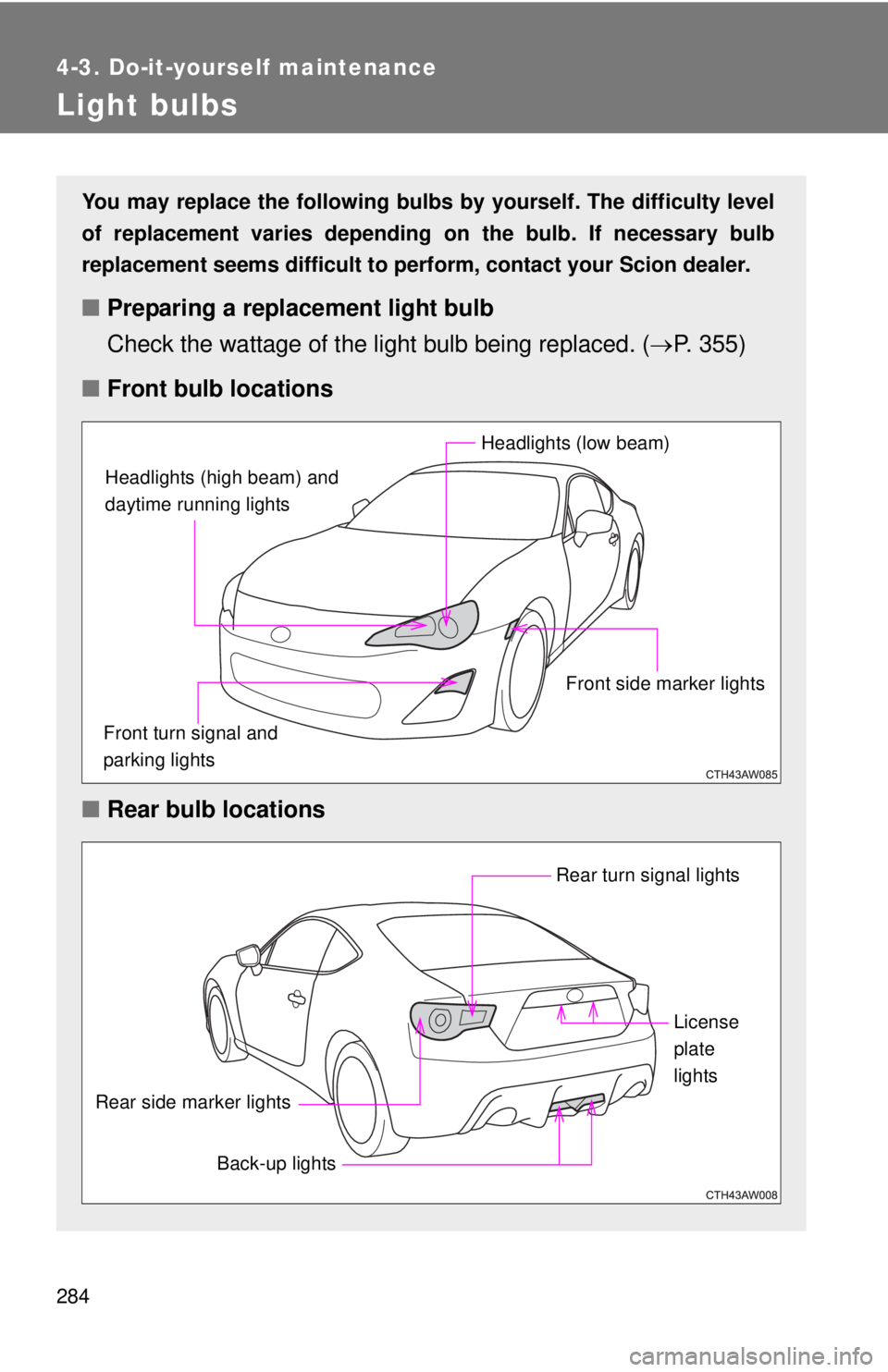
284
4-3. Do-it-yourself maintenance
Light bulbs
You may replace the following bulbs by yourself. The difficulty level
of replacement varies depending on the bulb. If necessary bulb
replacement seems difficult to perf orm, contact your Scion dealer.
■Preparing a replacement light bulb
Check the wattage of the light bulb being replaced. ( P. 355)
■ Front bulb locations
■ Rear bulb locations
Headlights (high beam) and
daytime running lights
Headlights (low beam)
Front side marker lights
Front turn signal and
parking lights
Rear turn signal lights
Rear side marker lights
Back-up lights License
plate
lights
Page 295 of 416
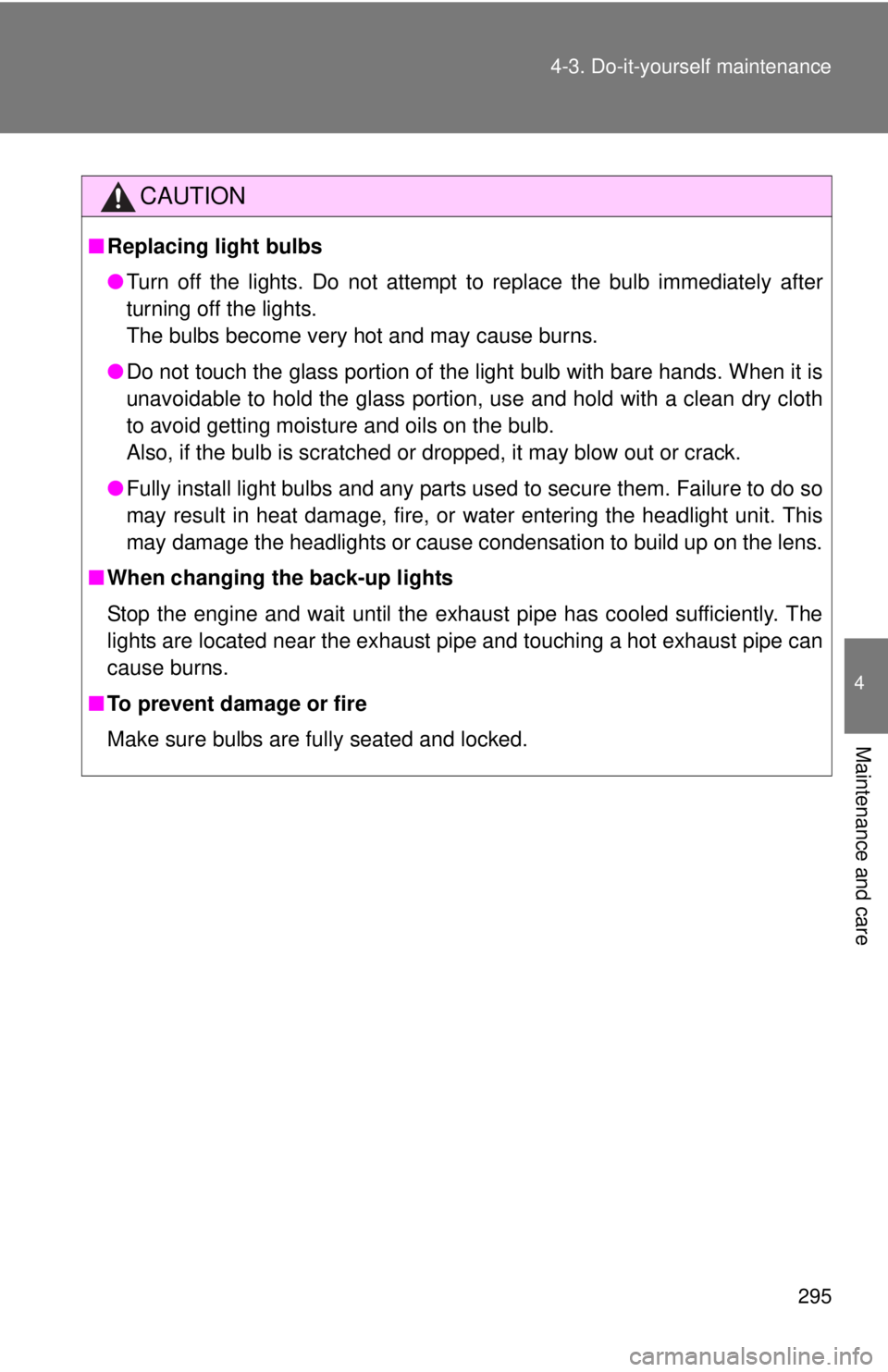
295
4-3. Do-it-yourself maintenance
4
Maintenance and care
CAUTION
■
Replacing light bulbs
●Turn off the lights. Do not attempt to replace the bulb immediately after
turning off the lights.
The bulbs become very hot and may cause burns.
● Do not touch the glass portion of the light bulb with bare hands. When i\
t is
unavoidable to hold the glass portion, use and hold with a clean dry cloth
to avoid getting moisture and oils on the bulb.
Also, if the bulb is scratched or dropped, it may blow out or crack.
● Fully install light bulbs and any parts used to secure them. Failure to do so
may result in heat damage, fire, or water entering the headlight unit. This
may damage the headlights or cause condensation to build up on the lens.
■ When changing the back-up lights
Stop the engine and wait until the exhaust pipe has cooled sufficiently. The
lights are located near the exhaust pipe and touching a hot exhaust pipe can
cause burns.
■ To prevent damage or fire
Make sure bulbs are fully seated and locked.
Page 329 of 416
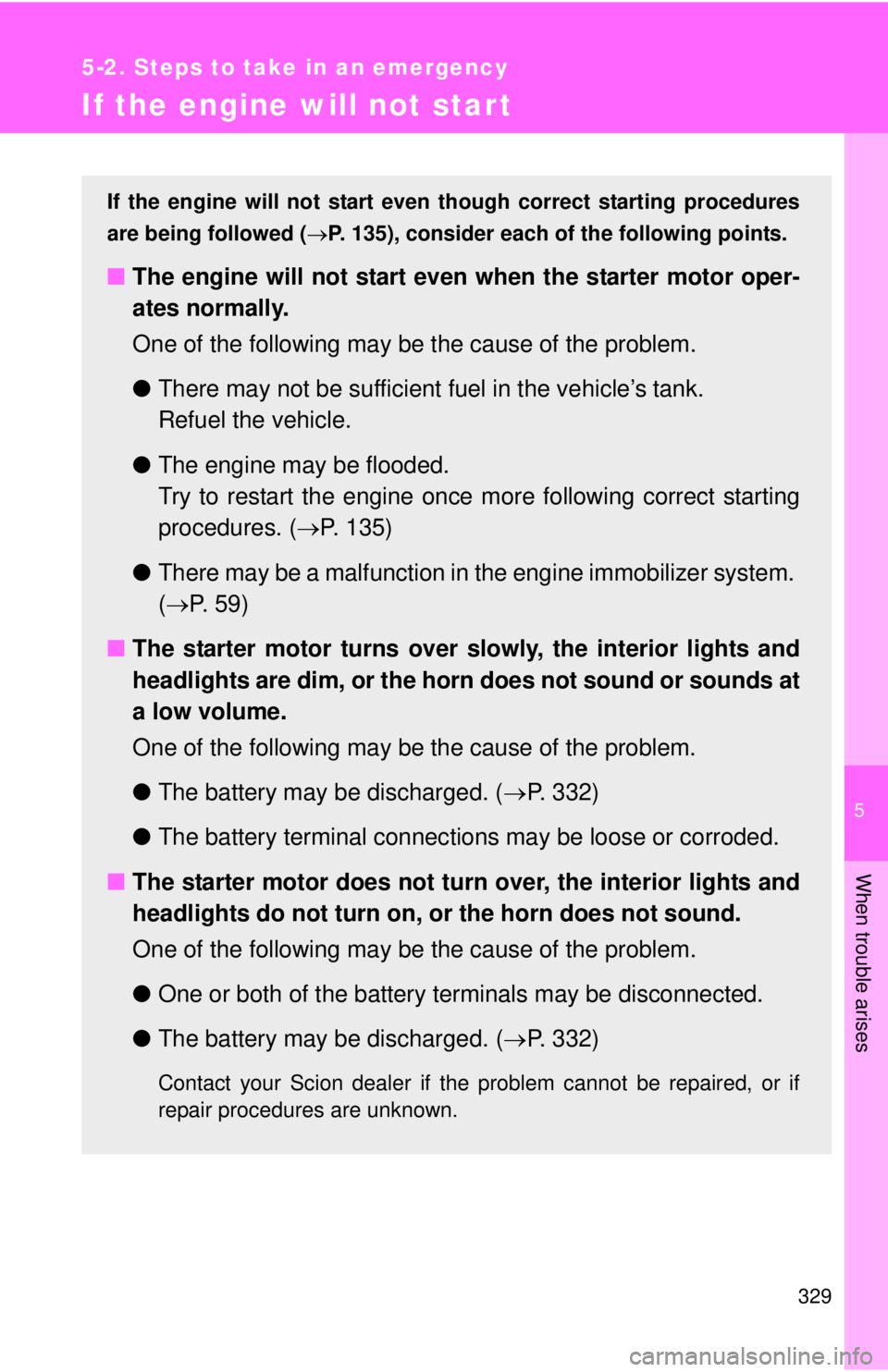
5
When trouble arises
329
5-2. Steps to take in an emergency
If the engine will not star t
If the engine will not start even though correct starting procedures
are being followed ( P. 135), consider each of the following points.
■The engine will not start even when the starter motor oper-
ates normally.
One of the following may be the cause of the problem.
●There may not be sufficient fuel in the vehicle’s tank.
Refuel the vehicle.
● The engine may be flooded.
Try to restart the engine once more following correct starting
procedures. ( P. 135)
● There may be a malfunction in the engine immobilizer system.
( P. 5 9 )
■ The starter motor turns over slowly, the interior lights and
headlights are dim, or the horn does not sound or sounds at
a low volume.
One of the following may be the cause of the problem.
●The battery may be discharged. ( P. 332)
● The battery terminal connec tions may be loose or corroded.
■ The starter motor does not turn over, the interior lights and
headlights do not turn on, or the horn does not sound.
One of the following may be the cause of the problem.
● One or both of the battery terminals may be disconnected.
● The battery may be discharged. ( P. 332)
Contact your Scion dealer if the problem cannot be repaired, or if
repair procedures are unknown.
Page 333 of 416
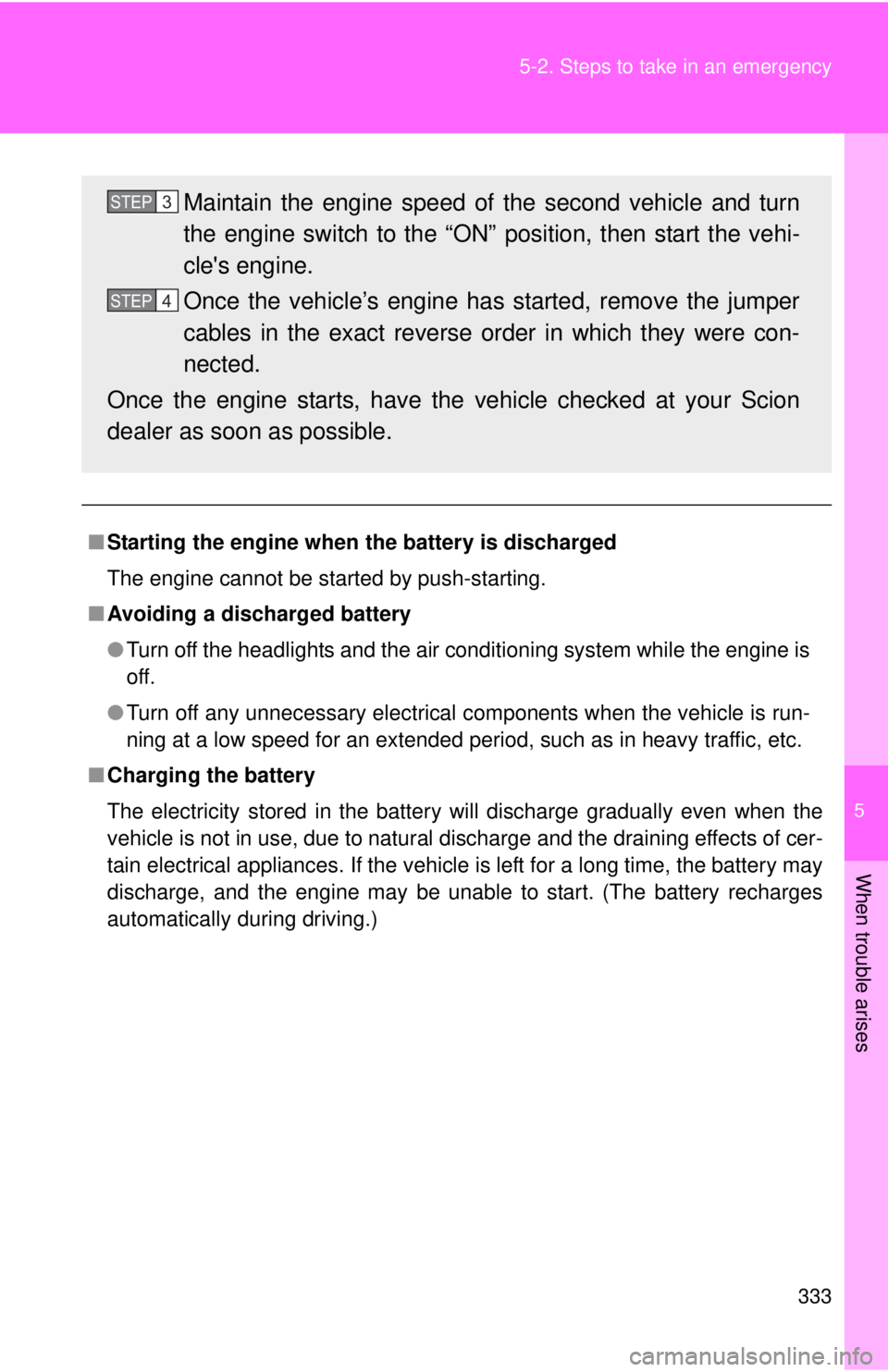
5
When trouble arises
333
5-2. Steps to take in an emergency
■
Starting the engine when the battery is discharged
The engine cannot be started by push-starting.
■ Avoiding a discharged battery
●Turn off the headlights and the air conditioning system while the engine is
off.
● Turn off any unnecessary electrical components when the vehicle is run-
ning at a low speed for an extended period, such as in heavy traffic, etc.
■ Charging the battery
The electricity stored in the battery will discharge gradually even when the
vehicle is not in use, due to natural discharge and the draining effects of cer-
tain electrical appliances. If the vehicle is left for a long time, the battery may
discharge, and the engine may be unable to start. (The battery recharges
automatically during driving.)
Maintain the engine speed of the second vehicle and turn
the engine switch to the “ON” position, then start the vehi-
cle's engine.
Once the vehicle’s engine has started, remove the jumper
cables in the exact reverse order in which they were con-
nected.
Once the engine starts, have the vehicle checked at your Scion
dealer as soon as possible.STEP 3
STEP 4